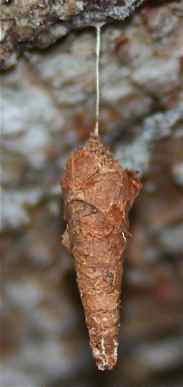We made an earlier post showing Red-Breasted Parakeets (Psittacula alexandri) feasting on “cocoons” attached to a defoliated yellow flame tree (Peltophorum pterocarpum). The image of the “cocoon” was not detailed enough for proper identification. However, Godfrey commented that it looks like the caterpillar of the bagworm moth (Psychidae).
Psychidae is a family of moths whose caterpillars have the habit of weaving bags out of tough silk around themselves and attaching pieces of dried vegetation to the bag – thus commonly known as bagworm moths. The caterpillar thus has a portable home, never leaving the bag. It feeds with only the head, thorax and legs protruding from the bag. At the first sign of danger, the caterpillar retracts back into the safety of their bag.
The caterpillars pupates inside the bag. If a female emerges from the pupa, she will never leave the bag, even laying her eggs inside after mating. The female is wingless, unlike the male, which is winged and free-flying.
On hatching the young caterpillars make their way out onto the surface of the leaf, taking pieces from the parent bag to spin their very own bags. Often, the newly hatched caterpillars spin a fine thread on which they are blown by the wind to surrounding trees. Caterpillars of bagworm moths are often pests of crops like palm oil and cocoa, causing serious damage.
Subsequently, Kwong Wai Chong managed to photograph the “cocoon” showing more details (above). This image was sent to various students of butterflies/moths for their comments. All agree that you need to rear the “cocoons” to see what exactly emerge.
Gan Cheong Weei of the Butterfly Interest Group believes that it could be a cocoon of a hymenoptera. Dr Leong Tzi Ming on the other hand agrees that it could be a Psychidae or other families of micro-moths but we should look at the emerging moth to confirm.
Khew Sin Khoon of the Butterfly Circle was kind enough to consult Dr Roger Kendrick, a moth expert who wrote: “There are many species of bagworms (family Psychidae), and I am not at all familiar with most of them. This photo could be of a bagworm larva, or even of a hymenoptera pupa (some ichnumonids pupate inside a cocoon on a thread like this). The only way to properly answer the question would be to take a few and rear them through to adults – noting that the females of many pychids are apterous and stay inside the case.”
References:
1. Barlow, H.S. (1982). An introduction to the moths of South East Asia, Malayan Nature Society, Kuala Lumpur.
2. Skaife, S. H., 1997. African insect life. (5th Impression, revised by J. Ledger). Struik Publishers, Capetown. 279 pp.










2 Responses
Just wondering if it is possible to acquire some of these cocoons and rear them to adulthood? Just curious as to what family they belong to.
We shall try, if the cocoons are still around and within reach.